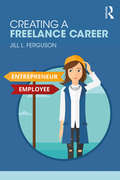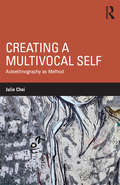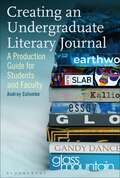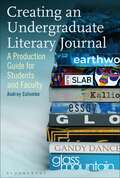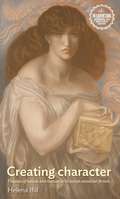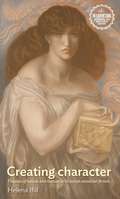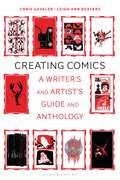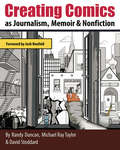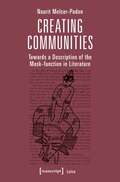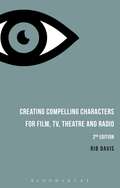- Table View
- List View
Creating a Freelance Career
by Jill L. FergusonCreating a Freelance Career covers everything anyone needs to know about becoming a freelance writer, graphic designer, copy editor, artist, musician or any other creative occupation. It includes chapters on how to get started with your career and where to look for work, how to write pitch or query letters, how to work with contract employers, and how to build and sustain your business. Lingo necessary for successfully navigating the freelance world is defined throughout. Author Jill L. Ferguson, an experienced freelance professional and educator, guides you through finding success in the gig economy, discussing how to pursue freelancing with an entrepreneurial spirit. Creating a Freelance Career includes examples of what to do, and what not to do, when pursuing freelance projects, and includes perspectives from additional real-life professionals who have found success in their fields.
Creating a Freelance Career
by Jill L. FergusonCreating a Freelance Career covers everything anyone needs to know about becoming a freelance writer, graphic designer, copy editor, artist, musician or any other creative occupation. It includes chapters on how to get started with your career and where to look for work, how to write pitch or query letters, how to work with contract employers, and how to build and sustain your business. Lingo necessary for successfully navigating the freelance world is defined throughout. Author Jill L. Ferguson, an experienced freelance professional and educator, guides you through finding success in the gig economy, discussing how to pursue freelancing with an entrepreneurial spirit. Creating a Freelance Career includes examples of what to do, and what not to do, when pursuing freelance projects, and includes perspectives from additional real-life professionals who have found success in their fields.
Creating a Multivocal Self: Autoethnography as Method
by Julie ChoiShowcasing a new methodology in language learning and identity research, this carefully conceptualized, innovative book explicates the use of autoethnography as a way of re-imagining one’s sense of linguistic and cultural identity. A key work for researchers and students in Applied Linguistics and Language Education, it addresses fundamental aspects of research methodology and explores substantive issues relating to individual dimensions of multilingualism. Choi shows convincingly how the learning of a language is inseparable from one’s constant searching for a voice, a place, and a self in this world, demonstrating the importance of interrogating what lies behind everyday life events and interactions—the political and ethical implications of the utterances, thoughts, actions, and stories of the self and others. Themes of authenticity, illegitimacy, power relations, perceptions of self/other, cultural discourses and practices, and related issues in multilingual identity development surface in the multi-modal narratives. Chapters on methodology, woven through the book, focus on the process of knowledge production, approaches to writing narratives, the messiness of research writing practices, and the inseparability of writing and research.
Creating a Multivocal Self: Autoethnography as Method
by Julie ChoiShowcasing a new methodology in language learning and identity research, this carefully conceptualized, innovative book explicates the use of autoethnography as a way of re-imagining one’s sense of linguistic and cultural identity. A key work for researchers and students in Applied Linguistics and Language Education, it addresses fundamental aspects of research methodology and explores substantive issues relating to individual dimensions of multilingualism. Choi shows convincingly how the learning of a language is inseparable from one’s constant searching for a voice, a place, and a self in this world, demonstrating the importance of interrogating what lies behind everyday life events and interactions—the political and ethical implications of the utterances, thoughts, actions, and stories of the self and others. Themes of authenticity, illegitimacy, power relations, perceptions of self/other, cultural discourses and practices, and related issues in multilingual identity development surface in the multi-modal narratives. Chapters on methodology, woven through the book, focus on the process of knowledge production, approaches to writing narratives, the messiness of research writing practices, and the inseparability of writing and research.
Creating an Undergraduate Literary Journal: A Production Guide for Students and Faculty
by Audrey ColombeUniversity literary journals allow students to create their own venue for learning, have a hands-on part of their development in real-world skills, and strive towards professional achievement. But producing an undergraduate literary magazine requires commitment, funding, and knowledge of the industry. This practical guide assists students and faculty in choosing a workable structure for setting up, and then successfully running, their own literary publication. Whether the journal is print or online, in-house or international, Creating an Undergraduate Literary Journal is a step-by-step handbook, walking the reader through the process of literary journal production. Chapters focus on: defining the journal; the financial logistics; editing the journal; distribution; and what could come next for a student writer-editor after graduation. The first book of its kind to offer instruction directly to those running university-based literary magazines, this book includes insights from former editors, advisers, students and features an extensive list of active student-run literary magazines key literary organizations for writers/editors who serve literary publications. From Audrey Colombe, faculty adviser on the award-winning Glass Mountain magazine from the University of Houston, this is a text for both newcomers and those more informed on the production process to help them navigate through a successful publishing experience.
Creating an Undergraduate Literary Journal: A Production Guide for Students and Faculty
by Audrey ColombeUniversity literary journals allow students to create their own venue for learning, have a hands-on part of their development in real-world skills, and strive towards professional achievement. But producing an undergraduate literary magazine requires commitment, funding, and knowledge of the industry. This practical guide assists students and faculty in choosing a workable structure for setting up, and then successfully running, their own literary publication. Whether the journal is print or online, in-house or international, Creating an Undergraduate Literary Journal is a step-by-step handbook, walking the reader through the process of literary journal production. Chapters focus on: defining the journal; the financial logistics; editing the journal; distribution; and what could come next for a student writer-editor after graduation. The first book of its kind to offer instruction directly to those running university-based literary magazines, this book includes insights from former editors, advisers, students and features an extensive list of active student-run literary magazines key literary organizations for writers/editors who serve literary publications. From Audrey Colombe, faculty adviser on the award-winning Glass Mountain magazine from the University of Houston, this is a text for both newcomers and those more informed on the production process to help them navigate through a successful publishing experience.
Creating and Digitizing Language Corpora: Volume 1: Synchronic Databases
by J. Beal K. Corrigan H. MoislA range of electronic corpora is increasingly accessible via the WWW and CD-ROM. This development coincided with improved standards governing the collecting, encoding and archiving of such data. This book looks at developing similar standards for enriching and preserving unconventional data: dialects, child language and bilingual databases.
Creating and Digitizing Language Corpora: Volume 3: Databases for Public Engagement
by Karen P. Corrigan Adam MearnsThis book unites a range of approaches to the collection and digitization of diverse language corpora. Its specific focus is on best practices identified in the exploitation of these resources in landmark impact initiatives across different parts of the globe. The development of increasingly accessible digital corpora has coincided with improvements in the standards governing the collection, encoding and archiving of ‘Big Data’. Less attention has been paid to the importance of developing standards for enriching and preserving other types of corpus data, such as that which captures the nuances of regional dialects, for example. This book takes these best practices another step forward by addressing innovative methods for enhancing and exploiting specialized corpora so that they become accessible to wider audiences beyond the academy.
Creating and Digitizing Language Corpora: Volume 2: Diachronic Databases
by David DenisonA range of electronic corpora has become accessible via the WWW and CD-ROM. This coincides with improvements in standards governing the collecting, encoding and archiving of such data. This book develops similar standards for enriching and preserving 'unconventional' data': the fragmentary texts and voices left to us as accidents of history.
Creating Belonging in San Francisco Chinatown’s Diasporic Community: Morphosyntactic Aspects of Indexing Ethnic Identity
by Adina StaicovThis book presents a much-needed discussion on ethnic identification and morphosyntactic variation in San Francisco Chinatown—a community that has received very little attention in linguistic research. An investigation of original, interactive speech data sheds light on how first- and second-generation Chinese Americans signal (ethnic) identity through morphosyntactic variation in English and on how they co-construct identity discursively. After an introduction to the community’s history, the book provides background information on ethnic varieties in North America. This discussion grounds the present book within existing research and illustrates how studies on ethnic varieties of English have evolved. The book then proceeds with a description of quantitative and qualitative results on linguistic variation and ethnic identity. These analyses show how linguistic variation is only one way of signalling belonging to a community and highlight that Chinese Americans draw on a variety of sources, most notably the heritage language, to construct and negotiate (ethnic) identity. This book will be of particular interest to linguists - particularly academics working in sociolinguistics, language and identity, and language variation - but also to scholars interested in related issues such as migration, discrimination, and ethnicity.
Creating character: Theories of nature and nurture in Victorian sensation fiction (G - Reference, Information and Interdisciplinary Subjects)
by Helena IfillThis book explores the ways in which the two leading sensation authors of the 1860s, Mary Elizabeth Braddon and Wilkie Collins, engaged with nineteenth-century ideas about personality formation and the extent to which it can be influenced either by the subject or by others. Innovative readings of seven sensation novels explore how they employ and challenge Victorian theories of heredity, degeneration, inherent constitution, education, upbringing and social circumstance. Far from presenting a reductive depiction of ‘nature’ versus ‘nurture’, Braddon and Collins show the creation of character to be a complex interplay of internal and external factors. Drawing on material ranging from medical textbooks, to sociological treatises, to popular periodicals, Creating character shows how sensation authors situated themselves at the intersections of established and developing, conservative and radical, learned and sensationalist thought about how identity could be made and modified.
Creating character: Theories of nature and nurture in Victorian sensation fiction (Interventions: Rethinking the Nineteenth Century)
by Helena IfillThis book explores the ways in which the two leading sensation authors of the 1860s, Mary Elizabeth Braddon and Wilkie Collins, engaged with nineteenth-century ideas about personality formation and the extent to which it can be influenced either by the subject or by others. Innovative readings of seven sensation novels explore how they employ and challenge Victorian theories of heredity, degeneration, inherent constitution, education, upbringing and social circumstance. Far from presenting a reductive depiction of ‘nature’ versus ‘nurture’, Braddon and Collins show the creation of character to be a complex interplay of internal and external factors. Drawing on material ranging from medical textbooks, to sociological treatises, to popular periodicals, Creating character shows how sensation authors situated themselves at the intersections of established and developing, conservative and radical, learned and sensationalist thought about how identity could be made and modified.
Creating Comics: A Writer's and Artist's Guide and Anthology (Bloomsbury Writers’ Guides and Anthologies)
by Chris Gavaler Leigh Ann BeaversFor creative writers and artists, comics provide unique opportunities for expression – but unique challenges, too. Creating Comics brings together in one volume an authoritative guide to the creative process, with practical drawing exercises throughout and an anthology of comics demonstrating the eclectic possibilities of the form. Creating Comic covers: · Using images to conceive and develop characters and stories· The complete range of possible relationships between two images· The step-by-step structure of visual narratives· How to approach each page like a unique canvas· Combining words and images to create new meanings Fully integrated with the main guide, the anthology section includes work by creators including: Lynda Barry, Alison Bechdel, Jaime Hernandez, Marjane Satrapi, Adrian Tomine, and many others.
Creating Comics: A Writer's and Artist's Guide and Anthology (Bloomsbury Writers’ Guides and Anthologies)
by Chris Gavaler Leigh Ann BeaversFor creative writers and artists, comics provide unique opportunities for expression – but unique challenges, too. Creating Comics brings together in one volume an authoritative guide to the creative process, with practical drawing exercises throughout and an anthology of comics demonstrating the eclectic possibilities of the form. Creating Comic covers: · Using images to conceive and develop characters and stories· The complete range of possible relationships between two images· The step-by-step structure of visual narratives· How to approach each page like a unique canvas· Combining words and images to create new meanings Fully integrated with the main guide, the anthology section includes work by creators including: Lynda Barry, Alison Bechdel, Jaime Hernandez, Marjane Satrapi, Adrian Tomine, and many others.
Creating Comics as Journalism, Memoir and Nonfiction
by Randy Duncan Michael Ray Taylor David StoddardThis book provides student journalists, artists, designers, creative writers and web producers with the tools and techniques they need to tell nonfiction stories visually and graphically. Weaving together history, theory, and practical advice, seasoned nonfiction comics professors and scholars Randy Duncan, Michael Ray Taylor and David Stoddard present a hands-on approach to teach readers from a range of backgrounds how to develop and create a graphic nonfiction story from start to finish. The book offers guidance on: -how to find stories and make use of appropriate facts and visuals; -nonfiction narrative techniques; -artist's tools and techniques; -print, digital, and multimedia production; -legal and ethical considerations. Interviews with well-known nonfiction comics creators and editors discuss best practices and offer readers inspiration to begin creating their own work, and exercises at the end of each chapter encourage students to hone their skills.
Creating Comics as Journalism, Memoir and Nonfiction
by Randy Duncan Michael Ray Taylor David StoddardThis book provides student journalists, artists, designers, creative writers and web producers with the tools and techniques they need to tell nonfiction stories visually and graphically. Weaving together history, theory, and practical advice, seasoned nonfiction comics professors and scholars Randy Duncan, Michael Ray Taylor and David Stoddard present a hands-on approach to teach readers from a range of backgrounds how to develop and create a graphic nonfiction story from start to finish. The book offers guidance on: -how to find stories and make use of appropriate facts and visuals; -nonfiction narrative techniques; -artist's tools and techniques; -print, digital, and multimedia production; -legal and ethical considerations. Interviews with well-known nonfiction comics creators and editors discuss best practices and offer readers inspiration to begin creating their own work, and exercises at the end of each chapter encourage students to hone their skills.
Creating Communities: Towards a Description of the Mask-function in Literature (Lettre)
by Nourit Melcer-PadonHow does historical reality interrelate with fiction? And how much are readers themselves involved in the workings of fictional literature? With innovative interpretations of various well-known texts, Nourit Melcer-Padon introduces the use of literary masks and illustrates literature's engagement of its readers' ethical judgement. She promotes a new perception of literary theory and of connections between thinkers such as Iser, Castoriadis, Sartre, Jung and Neumann. The book offers a unique view on the role of the community in post-existentialist modern cultural reality by emphasizing the importance of ritual practices in literature as a cultural manifestation.
Creating Communities: Towards a Description of the Mask-function in Literature (Lettre)
by Nourit Melcer-PadonHow does historical reality interrelate with fiction? And how much are readers themselves involved in the workings of fictional literature? With innovative interpretations of various well-known texts, Nourit Melcer-Padon introduces the use of literary masks and illustrates literature's engagement of its readers' ethical judgement. She promotes a new perception of literary theory and of connections between thinkers such as Iser, Castoriadis, Sartre, Jung and Neumann. The book offers a unique view on the role of the community in post-existentialist modern cultural reality by emphasizing the importance of ritual practices in literature as a cultural manifestation.
Creating Compelling Characters for Film, TV, Theatre and Radio
by Rib DavisStrong characters – characters we love and hate, those we despair for at their low moments and egg on to their triumphs – are the foundation of any successful script. Written by award-winning writer Rib Davis and now fully updated for its second edition, Creating Compelling Characters for Film, TV, Theatre and Radio is an authoritative practical guide to developing characters for professional and aspiring writers alike.As well as exploring character motivation, the interplay between character and plot, comic characters, heroes and villains, the new edition also includes a more in-depth look at character psychology, writing ensemble and multi-narrative dramas and the balance between character development and character revelation. The book also includes a wide range of contemporary examples from scripts ranging from films such as The Wolf of Wall Street and The Grand Budapest Hotel, award-winning plays such as Jerusalem and acclaimed TV shows such as Game of Thrones and True Detective.
Creating Compelling Characters for Film, TV, Theatre and Radio
by Rib DavisStrong characters – characters we love and hate, those we despair for at their low moments and egg on to their triumphs – are the foundation of any successful script. Written by award-winning writer Rib Davis and now fully updated for its second edition, Creating Compelling Characters for Film, TV, Theatre and Radio is an authoritative practical guide to developing characters for professional and aspiring writers alike.As well as exploring character motivation, the interplay between character and plot, comic characters, heroes and villains, the new edition also includes a more in-depth look at character psychology, writing ensemble and multi-narrative dramas and the balance between character development and character revelation. The book also includes a wide range of contemporary examples from scripts ranging from films such as The Wolf of Wall Street and The Grand Budapest Hotel, award-winning plays such as Jerusalem and acclaimed TV shows such as Game of Thrones and True Detective.
Creating Context in Andean Cultures (Oxford Studies in Anthropological Linguistics)
by Rosaleen Howard-MalverdeA major concern in current anthropological thinking is that the method of recording or translating into writing a society's cultural expressions--dance, rituals, pottery, the social use of space, et al--cannot help but fundamentally alter the meaning of the living words and deeds of the culture in question. Consequently, recent researchers have developed more dialogic methods for collecting, interpreting, and presenting data. These new techniques have yielded much success for anthropologists working in Latin America, especially in their efforts to understand how economically, politically, and socially subordinated groups use culture and language to resist the dominant national culture and to assert a distinct historical identity. This collection addresses these issues of "texts" and textuality as it explores various Latin American languages and cultures.
Creating Critical Classrooms: Reading and Writing with an Edge
by Mitzi Lewison Christine Leland Jerome C. HarsteThis popular text articulates a powerful theory of critical literacy—in all its complexity. Critical literacy practices encourage students to use language to question the everyday world, interrogate the relationship between language and power, analyze popular culture and media, understand how power relationships are socially constructed, and consider actions that can be taken to promote social justice. By providing both a model for critical literacy instruction and many examples of how critical practices can be enacted in daily school life in elementary and middle school classrooms, Creating Critical Classrooms meets a huge need for a practical, theoretically based text on this topic. Pedagogical features in each chapter • Teacher-researcher Vignette • Theories that Inform Practice • Critical Literacy Chart • Thought Piece • Invitations for Disruption • Lingering Questions New in the Second Edition • End-of-chapter "Voices from the Field" • More upper elementary-grade examples • New text sets drawn from "Classroom Resources" • Streamlined, restructured, revised, and updated throughout • Expanded Companion Website now includes annotated Classroom Resources; Text Sets; Resources by Chapter; Invitations for Students; Literacy Strategies; Additional Resources
Creating Critical Classrooms: Reading and Writing with an Edge
by Mitzi Lewison Christine Leland Jerome C. HarsteThis popular text articulates a powerful theory of critical literacy—in all its complexity. Critical literacy practices encourage students to use language to question the everyday world, interrogate the relationship between language and power, analyze popular culture and media, understand how power relationships are socially constructed, and consider actions that can be taken to promote social justice. By providing both a model for critical literacy instruction and many examples of how critical practices can be enacted in daily school life in elementary and middle school classrooms, Creating Critical Classrooms meets a huge need for a practical, theoretically based text on this topic. Pedagogical features in each chapter • Teacher-researcher Vignette • Theories that Inform Practice • Critical Literacy Chart • Thought Piece • Invitations for Disruption • Lingering Questions New in the Second Edition • End-of-chapter "Voices from the Field" • More upper elementary-grade examples • New text sets drawn from "Classroom Resources" • Streamlined, restructured, revised, and updated throughout • Expanded Companion Website now includes annotated Classroom Resources; Text Sets; Resources by Chapter; Invitations for Students; Literacy Strategies; Additional Resources
Creating Dialogue for TV: Screenwriters Talk Television (Routledge Studies in Media Theory and Practice)
by Monika BednarekAs entertaining as it is enlightening, Creating Dialogue for TV: Screenwriters Talk Television presents interviews with five Hollywood professionals who talk about all things related to dialogue – from naturalistic style to the building of characters to swearing and dialect. Screenwriters/showrunners David Mandel (Curb Your Enthusiasm, Veep), Jane Espenson (Buffy, Battlestar Galactica, Once Upon a Time), Robert Berens (Supernatural), Sheila Lawrence (Gilmore Girls, Ugly Betty, The Marvelous Mrs Maisel), and Doris Egan (Tru Calling, House, Reign) field a linguist’s inquiries about the craft of writing dialogue. This book is for anyone who has ever wondered what creative processes and attitudes lie behind the words they encounter when tuning into their favourite television show. It provides direct insights into Hollywood writers’ knowledge and opinions of how language is used in television narratives, and in doing so shows how language awareness, attitudes and the craft of using words are utilised to create popular TV series. The book will appeal to students and teachers in screenwriting, creative writing and linguistics as well as lay readers.
Creating Dialogue for TV: Screenwriters Talk Television (Routledge Studies in Media Theory and Practice)
by Monika BednarekAs entertaining as it is enlightening, Creating Dialogue for TV: Screenwriters Talk Television presents interviews with five Hollywood professionals who talk about all things related to dialogue – from naturalistic style to the building of characters to swearing and dialect. Screenwriters/showrunners David Mandel (Curb Your Enthusiasm, Veep), Jane Espenson (Buffy, Battlestar Galactica, Once Upon a Time), Robert Berens (Supernatural), Sheila Lawrence (Gilmore Girls, Ugly Betty, The Marvelous Mrs Maisel), and Doris Egan (Tru Calling, House, Reign) field a linguist’s inquiries about the craft of writing dialogue. This book is for anyone who has ever wondered what creative processes and attitudes lie behind the words they encounter when tuning into their favourite television show. It provides direct insights into Hollywood writers’ knowledge and opinions of how language is used in television narratives, and in doing so shows how language awareness, attitudes and the craft of using words are utilised to create popular TV series. The book will appeal to students and teachers in screenwriting, creative writing and linguistics as well as lay readers.
